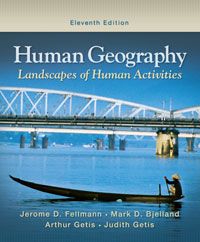1 A) Agglomeration economies lead to higher transport and labor costs. B) Labor is immobile in location, but infinitely available. C) Locations with high transport costs may be attractive because of a cheap labor supply. D) Transport costs were uniform by distance and weight in any direction. 2 A) London. B) the Ruhr Valley. C) the Saxony District. D) the Scottish Lowlands. 3 A) agglomeration B) least-cost C) locational interdependence D) profit maximization 4 A) secondary B) tertiary C) quaternary D) quinary 5 A) the extraction of natural resources. B) information processing. C) material processing and the production of goods. D) retailing and wholesaling activities. 6 A) the Delaware Valley. B) Megalopolis. C) New York City. D) the heart of the Anglo-Saxon Manufacturing Belt. 7 A) Kitakyushu. B) Kobe-Osaka. C) Nagoya. D) Tokyo. 8 A) comparative advantage. B) deglomeration. C) market orientation. D) material orientation. 9 A) Eastern Asia B) Eastern North America C) West and Central Europe D) Western South America 10 A) demand. B) maximizing profit. C) price. D) supply. 11 A) 15 B) 25 C) 30 D) 60 12 satisficing is to optimal as ___________.A) good is to best B) larger is to smaller C) incorrect is to correct D) left is to right 13 A) railroad B) inland waterways C) pipelines D) intermodal containerization 14 A) advanced high-tech regions. B) extreme environmental problems. C) highly efficient industrial districts. D) strong unionized labor forces. 15 A) at opposite ends of the market. B) at the midpoints of their halves of the market. C) one at one end of the market, the other at the midpoint. D) side-by-side clustered at the midpoint. 16 A) quaternary B) primary C) secondary D) tertiary 17 A) a carrier combines unprocessed commodities with finished goods. B) a transport carrier has made an intermediate stop before proceeding to the final destination. C) goods have to be transferred from one type of carrier to another. D) movement is interrupted for processing or manufacturing en route. 18 A) coal B) food processing C) iron and steel D) textiles 19 A) 5 B) 10 C) 25 D) 50 20 A) Eastern Asia. B) Northeastern North America. C) Paris. D) Western United States and Mexico. 21 A) quaternary activities. B) outsourcing. C) minimization of the total cost of collecting all the raw materials at one point. D) avoiding incompatible industries such as textiles and footwear. 22 A) their proximity to major populations. B) lower labor costs. C) better overland transportation routes than those found in Taiwan and Hong Kong. D) political instability in South Africa. 23 A) are fly-by-night operations. B) require multiple sources of raw materials. C) are found predominantly in inner cities. D) consider transport costs a negligible factor in production. 24 A) high market demand for products. B) regional specializations. C) locating plants near raw material sources. D) lower wage rates in the United States. 25 A) regional self-sufficiency. B) the individual firm. C) the location of the consumer market. D) the location of the raw materials.





